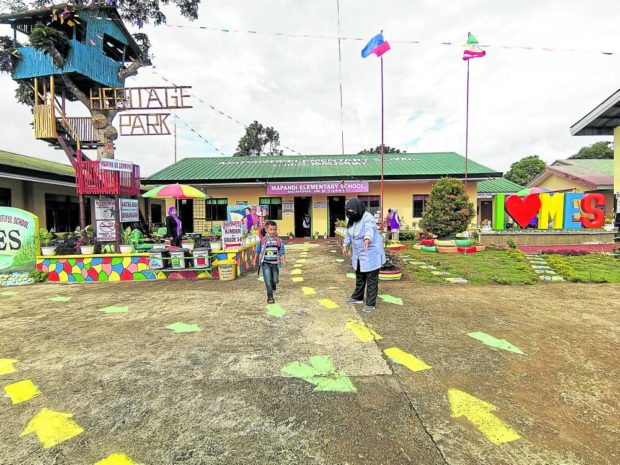
GUIDING HANDS: A teacher guides a pupil during the simulation exercises on Feb. 3 to prepare for the opening of limited in-person classes at Mapandi Elementary School in Barangay Gadongan, Marawi City, on Feb. 14. (Photo by DIVINA M. SUSON / Inquirer Mindanao)
MARAWI CITY, Lanao del Sur, Philippines — They haven’t started inoculating children between 5 to 11 years old yet but three elementary schools here will finally open limited in-person classes on Valentine’s Day.
Dr. Anna Zenaida Unte-Alonto, schools division superintendent in Marawi City, named the three schools ready for limited in-person classes as Angoyao Elementary School of Barangay Paridi, Mapandi Elementary School of Barangay Gadongan and Nanapun Elementary School of Barangay Bangon.
She said the three elementary schools had already undergone the necessary simulation exercises that prepared them for problems that could possibly arise during the actual classes that would start on Feb. 14.
The three elementary schools had also complied with the Department of Education requirements for the holding of limited physical classes, she added.
The Bangsamoro Autonomous Region of Muslim Mindanao’s Ministry of Basic, Higher and Technical Education has previously identified 27 schools in the city considered to be low risk for the coronavirus disease, hence, conducive to limited in-person learning.
But the Marawi schools division still chose the three schools as the priority, Alonto said.
Simulation
She said they opted to focus on schools with vaccinated teachers, those in far-flung communities and those that were seen to be ready but just needed to be oriented to be more prepared.
In a simulation activity held in Barangay Mapandi on Feb. 3, at least 100 learners from kindergarten to Grade 2 were excited to get inside the classroom for the first time in two years. Those in these three levels were first-timers since their modular classes had all been confined at home in the last two years because of the pandemic.
Outside each classroom, a washing area has been set up with hand soap, alcohol, hand towel, and a shoe box where learners leave their shoes and change into slippers for use inside the classroom.
Aside from the usual learning materials and books, each classroom was equipped with a body thermometer, box of face masks, alcohol and disinfection spray.
Classes would only take two hours each day, from 7 a.m. to 9 a.m., Alonto said
Each classroom has 70 learners but these learners would be grouped into four, so that each group would get to attend one week of in-person classes in a month while maintaining physical distancing inside the room. The rest of the month they will have to spend at home under modular learning.
The learners would use school-provided slippers inside their classroom so that they could leave their shoes in a shoe box outside, said Rohana Usman, a nurse at Mapandi Elementary School.
She said they also did away with plastic cubicles to separate the learners to ensure proper ventilation inside the classroom, particularly since the children would also be wearing face masks and face shields.
Some teachers expected some learners to complain about difficulty breathing through their face masks. In that case, they might consider taking off the mask of one child as long as all other classmates would still be wearing theirs, she said.